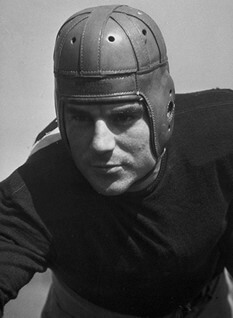Marchy Schwartz was one of the greatest running backs in Notre Dame history. Twice he earned All-American honors (1930, 1931). Twice he played for undefeated national championship teams under Knute Rockne (1929, 1930). For a number of years, he was the second all-time leading rusher in Irish history behind George Gipp.
A 1962 national poll of sportswriters and broadcasters placed Schwartz on Notre Dame’s all-time team, starting in the backfield alongside Gipp, Johnny Lujack and Jim Crowley. In 1974, he was inducted into the College Football Hall of Fame. Schwartz was also Jewish, a fact that seems to have been little-noticed on the Notre Dame campus or football team but was hashed over frequently by the nation’s sporting press.
Schwartz wasn’t Notre Dame’s first Jewish player. Quarterback Nate Silver, who played from 1903 to 1905, seems to have been the first. There were other Jewish football players at Notre Dame during Schwartz’s era as well, including guard Norman Herwit and back Clarence Kaplan. But Schwarz was the school’s first Jewish athletic star to gain national recognition. His success in South Bend demonstrated Notre Dame’s relative inclusiveness in an era when many prominent institutions either by rule or practice barred Jews (or Catholics, for that matter). Rockne, who recruited Schwarz and coached him between 1928 and 1930, made a point of recruiting Jewish players and, on multiple occasions, earmarked a portion of football gate receipts to support Jewish charities.
Marchmont H. Schwartz was born in New Orleans on March 20, 1909 to a Jewish father and an Irish mother. His first name, “Marchmont,” was the name of a 20-to-1 odds racehorse that won his uncle $20 (roughly $600 in 2022 dollars) on the day baby was born. The young Schwartz grew up in Bay St. Louis, Mississippi, just across Lake Borgne from New Orleans.
“Marchy” (or “Marchie”), as he came to be known, grew to a sinewy 5-foot-11 and 170 pounds, large for a running back in his era. Scouts marveled at the power, agility and determination. He signed on with Loyola University of New Orleans, playing for the legendary Clark Shaughnessy, the inventor of the modern T formation. Rockne persuaded Schwartz to transfer before his sophomore season, assuring the budding backfield star that he would be featured in Notre Dame’s evolving box offense.

Rockne kept his promise. In a scheme built around misdirection and dexterity, Schwartz became one of its finest practitioners. He contributed to the undefeated national championship team of 1929 before bearing the bulk of Notre Dame’s offensive load in 1930, chugging his way to 928 yards rushing in 10 games and averaging 7.5 yards per carry. He also led the team in passing yards and touchdowns from the halfback position. Against Army, Schwartz broke a 54-yard touchdown run that helped push the Irish past their rival, 7-6, before 110,000 fans at Soldier Field. Defeating USC in the season finale sealed Notre Dame’s second consecutive undefeated record and another national title.
Schwartz was the team’s on-field leader in 1931, one of the most trying seasons in school history. Just months after Rockne’s death, new head coach Hunk Anderson relied heavily on the senior back. The Irish mustered a 6-2-1 record thanks in large part to Schwartz, who led the team in rushing, passing and punting. He finished his career with 1,945 rushing yards. Only George Gipp had ever run for more.
Following his graduation, Schwartz served for two seasons as an assistant under Hunk Anderson while finishing a law degree at Notre Dame. He spent 1934 working for his first college coach, Clark Shaughnessy, as an assistant at the University of Chicago. At age 26, Schwartz became head coach at Creighton in the Missouri Valley Conference.
After five up-and-down seasons in Omaha, Schwartz headed for the West Coast in 1940, working as an assistant again under Shaughnessy, who had moved on to Stanford. Schwartz helped Shaughnessy install the T formation, which transformed a team that had won just one game the previous season into a national power. Stanford’s backfield befuddled the opposition all year, just as the ever-elusive Schwartz had done a decade earlier in South Bend.
Shaughnessy’s team went undefeated, won the Pacific Coast Conference and defeated Nebraska in the 1941 Rose Bowl. Several national polls named Stanford the 1940 national champion. All four of the backfield starters whom Schwartz coached on the 1940 team went on to be selected in the NFL Draft.
Schwartz took over for Shaughnessy as head coach in 1942, guiding Stanford to a 6-4 record. For the next three seasons, Stanford shut down its program during World War II, but Schwartz returned to lead the team in 1946. He guided Stanford for the next five years before retiring from coaching at age 41.
Schwartz remained in the Bay Area, working in public relations and later becoming an executive with the Transamerica Title Insurance Company. He converted to Catholicism and raised five children with his wife, Rosemarie (O’Donnell), whom he had met while coaching at Creighton.
Schwartz retired to Danville, California, in Contra Costa County, remaining in good health well into his 80s. In early April 1991, he suffered a heart attack and died two weeks later at age 82.
Posthumous tributes to the man honored Schwartz’s success as a player, a coach and a businessman, as well as his groundbreaking role in the history of college football.
Clayton Trutor teaches history at Norwich University in Vermont. He is the author of Loserville: How Professional Sports Remade Atlanta — and How Atlanta Remade Professional Sports and the forthcoming Boston Ball: Jim Calhoun, Rick Pitino, Gary Williams, and College Basketball’s Forgotten Cradle of Coaches (2023). He’d love to hear from you on Twitter: @ClaytonTrutor